|
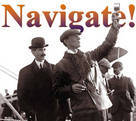
 Up
Up 
 A Warped
A Warped
Experiment

(You are here.)



  Need
to Need
to
find your
bearings?
Try
these
navigation aids:
If
this is your first
visit, please stop by:
Something
to share?
Please:



|
|
Available in Française, Español, Português, Deutsch, Россию,
中文,
日本, and others.
 mong
the many scientific books and papers that Wilbur waded through was
James Bell Pettigrew's Animal
Locomotion, or Walking , Swimming, and Flying, With a Dissertation on Aeronautics.
Pettigrew confirmed Will's observation that birds twisted their
wings in flight. "The wing is jointed to the upper part of the body
by a universal joint which admits every variety of motion..." wrote
Pettigrew. He went on to describe how the wings of both birds and
flying insects twisted along their long dimension "like a screw." He
was mostly concerned about describing how wings produce thrust and
lift, but Wilbur reasoned that the same motions could also be used
for aerodynamic control. mong
the many scientific books and papers that Wilbur waded through was
James Bell Pettigrew's Animal
Locomotion, or Walking , Swimming, and Flying, With a Dissertation on Aeronautics.
Pettigrew confirmed Will's observation that birds twisted their
wings in flight. "The wing is jointed to the upper part of the body
by a universal joint which admits every variety of motion..." wrote
Pettigrew. He went on to describe how the wings of both birds and
flying insects twisted along their long dimension "like a screw." He
was mostly concerned about describing how wings produce thrust and
lift, but Wilbur reasoned that the same motions could also be used
for aerodynamic control.
The Aileron Hypothesis
"The thought came to me," wrote
Wilbur, "that possibly [a bird] adjusted the tips of its wings…so as to present
one tip at a positive angle and the other at a negative angle, thus…turning itself
into an animated windmill, and that when its body had revolved…as far as it wished,
it reversed the process."
But how could they imitate this in a mechanical flying machine?
Orville suggested a system of intermeshed gears that would rotate
the left and right wings in opposite directions. But this seemed too
complex and too heavy to be of much use, as did other mechanical
devices that Wilbur and Orville envisioned. Additionally, if the wings
were rotated at their roots, they would have to be sufficiently
strong to support the aircraft and remain stiff without bracing.
This, too, would add weight. The machine and its control system had
to be simple, strong, and light.
The Elegant Solution
In July of 1899, Wilbur had just heard from the Smithsonian and
his mind was full of aeronautics and aerodynamics. While talking to
a customer at the bike shop, he picked up a long, slender
cardboard box that had once held an inner tube and idly began to toy with
it. He happened to place the thumb and forefinger of one hand on
diagonal corners at one end of the box, and the other thumb and
forefinger on the opposite diagonal corners at the other end.
He noticed that when he squeezed his thumbs and forefingers
together, the box twisted. The surfaces at each end rotated in
opposite directions. In his mind’s eye, Wilbur saw the
Chanute-Herring glider. The biplane was essentially a box with open
sides. With a set of cables, he could
twist the wings just as he twisted the box. When one wing tip turned
turned up, this would increase the lift at that end. Where the other
tip turned down, the lift would decrease. The difference in lift would
cause the biplane to roll to the right or left. (To repeat this experiment
for yourself, see the
Inner Tube Box Experiment in our Adventure Wing.)
Wing warping also solved the weight problem. The control cables
would weigh very little. And the wings could be lightly built; the
rigging would provide the strength and stiffness needed. Wilbur's
idea was what engineer's often refer to as the "elegant solution" –
a design or idea that appears remarkable for its simplicity and the
number of problems it solves. The elegant solution is to a scientist
or engineer what an inspiration is to an artist, and is just
emotionally satisfying and intellectually captivating. No doubt
Wilbur's customer left wondering what had suddenly distracted him.
The Wright Kite
The brothers had gotten into the habit of testing their
aeronautical ideas on kites or "model gliders," as they referred to
them. Within a few weeks, Wilbur built a large biplane kite with a wingspan of
72 inches (183 centimeters) and a chord of 18 inches (46
centimeters). It was the same aspect ratio as the Chanute-Herring
glider. (Aspect ratio is the wingspan or the length of the
wing divided by the chord or width.) You can see this kite in
detail in our
Virtual Hangar.
Or you can build and fly a smaller version yourself – see the
Not Quite Wright Kite. Wilbur fitted the kite
with controls that allowed him to twist or "warp" the wings from the
ground – this would roll the kite. It also had a movable tail to
control pitch. Control lines ran between the four forward corners of the
kite to the ends of two sticks, one in each of Wilbur's hands. When he
angled the sticks in opposite directions, the wings would twist one way or
the other, hopefully causing the kite to roll right or left. When he angled his hands
in the same direction, the tail would turn up or down, pitching the kite up
or down. On a windy day in late July or early August, Wilbur took the kite to a nearby
open space at the Union Biblical Seminary – a school his father had
helped establish. With him was a rag-tag collection of neighborhood
boys who came to see what he was up to. Later, several of them would
remember that when Wilbur flew the kite, it would swoop at them and
they dived for cover. But aside from scaring the neighbors' kids,
the controls worked just as Wilbur had expected. His hypothesis
would become an important aerodynamic design principle. Orville was camping with friends at the
time and Wilbur, too excited to wait for him to come home, rode his bicycle out to the
camp to tell his brother the good news. Immediately, the Wrights began to plan a glider with
"wing warping" controls.
|
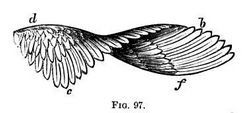
These illustrations from Pettigrew's
Animal Locomotion show how a bird's wing twists in
flight. The primary feathers are indicated by the label "b." To read the book, click on the title.
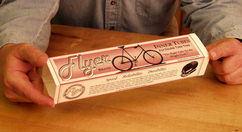
Click on the inner tube box to see how Wilbur
twisted it. If you'd like to try this experiment yourself, click
HERE
for instructions and a downloadable inner tube box you can print on card stock.
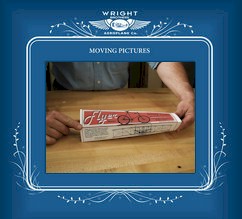
WBAC Director Nick Engler tells the
story of the
inner tube box and shows how to twist it in this video.
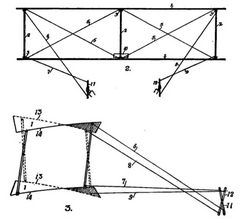
In 1912, Wilbur made these sketches of the 1899 kite
from memory.

Flying a replica of the 1899 Wright Kite. To see
more details, visit the
1899
Kite in our Virtual Hangar. For plans and instructions to build and
fly a smaller version, see the
Not Quite Wright Kite.
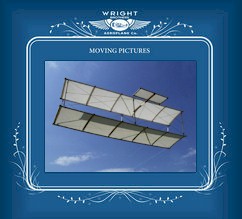
To see a video of the
1899 Wright Kite
in flight, click on the image above. |